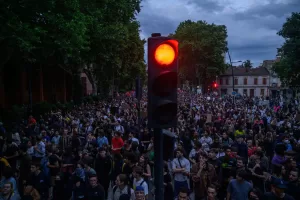Paris Marx
In an article I wrote some time ago, I discussed how to build a better food system that centres collective solutions rather than individualizing the problems of hunger and lack of access to good meals. But the individualization of society is something that has taken root on a much larger scale, and must be addressed if we’re to build a more sustainable and equitable world.
I view part of the shift from more collective and communal ways of life to the individualized notions we have today as originating with the transformation of cities that took place in the early to mid-20th century.
It can be difficult to remember today, but streets used to be shared spaces, not monopolized by automobiles with everyone else viewed as an intruder. Transport historian Peter Norton writes that, “Children at play belonged in streets. Most city people viewed streets as the proper setting for many others as well, from pedestrians to streetcar riders. They regarded the city street as a public space, open to anyone who did not endanger or obstruct other users.”
Cities were busy places and urban residents had other ways to get around, such as bikes and streetcars. Initially, they fought the cars that were slowly taking over city streets and killing its residents (children, in particular), but Norton notes that “those promoting reconstruction were a social elite” made up of corporate executives, urban planners, prominent politicians, police chiefs and eventually newspaper owners. They not only transformed the language we used to talk about streets, introducing terms like “jaywalker” to make people walking in the street seem like ignorant fools, but also began to rebuild cities around the automobile.
It’s important to remember that without state action, this wouldn’t have been nearly as successful. In the United States, the creation of the Federal Housing Authority in 1934 explicitly subsidized suburban development and disincentivized dense, urban living, while the funding of the Interstate highway system in 1956 — which cost about $500 billion — cemented the automobile’s supremacy. Urban highways were also often used as part of broader urban renewal campaigns designed to raze poor and Black communities.
Canada wasn’t immune to this phenomenon. The federal government founded the Canadian Mortgage and Housing Corporation (CMHC) in 1946 to provide housing for veterans returning from the Second World War. While it initially had some focus on public and rental housing, it also made mortgages much easier to obtain. As the federal government eventually cut its support for public housing, the CMHC increasingly supported suburban homeownership. In addition, the Trans-Canada Highway was approved in 1949 and completed in 1971.
This shift toward private car use and suburban, single-family homes also helped change people’s character. In 1973, journalist and philosopher André Gorz described how the car was inherently a luxury good whose benefits cannot be democratizing because there simply isn’t enough space in a city for everyone to have one. He compared it to a seaside villa — not everyone can own one, so the beach must be a communal space.
Gorz argued that mass automobility was “an absolute triumph of bourgeois ideology on the level of daily life,” making everyone believe “the illusion that each individual can seek his or her own benefit at the expense of everyone else.” This is undeniably linked to the mass consumption that also arose in the postwar period, when all of a sudden there were a ton of consumer goods for people to fill their new suburban homes.
The postwar, suburban, consumerist project was, at its core, an effort to further individualize our lives in service of corporate profits and GDP growth. Over time, private alternatives to communal spaces and experiences came to be seen as better and as a sign of social status.
People wanted private pools rather than going to the public ones. They got massive TVs, if not creating special cinema rooms in their ever-bigger homes, and frequented the cinema less often. They built in-home gyms, and had bigger yards so as to avoid public parks.
There are two things to understand about this move to private space. First, it’s encouraged by suburbanization. The longer you have to travel to get to a public space, the less likely you are to want to make the trip. Second, the fewer people use public spaces or community facilities, the more likely they are to receive less investment, if not close down altogether.
Studies have increasingly shown that there’s a growing crisis of loneliness in modern societies. It’s particularly acute in individualistic nations, and prolonged experiences of social isolation can result in a range of negative health outcomes. It should come as no surprise when there’s been a concerted attack on community and public spaces for decades because they don’t generate the kinds of profits as private, individualized spaces.
If we’re to build a better world, that needs to change. As I discussed in a previous issue, we need a significant shift back toward communal life and public solutions to our problems. Private transport, spaces and services only benefit those who can afford them, while a lack of public alternatives means the poor and working class no longer have access to those amenities.
As writer George Monbiot puts it, “Public luxury available to all, or private luxury available to some: this is the choice we face at all times.” We need “magnificent parks, playing fields, public swimming pools, urban nature reserves and allotments sufficient to meet the needs of everyone.” That’s the future we should be fighting for — not more private wealth so we can keep sealing ourselves off from everyone else.
(Paris Marx is a socialist writer and graduate student at McGill University.)




